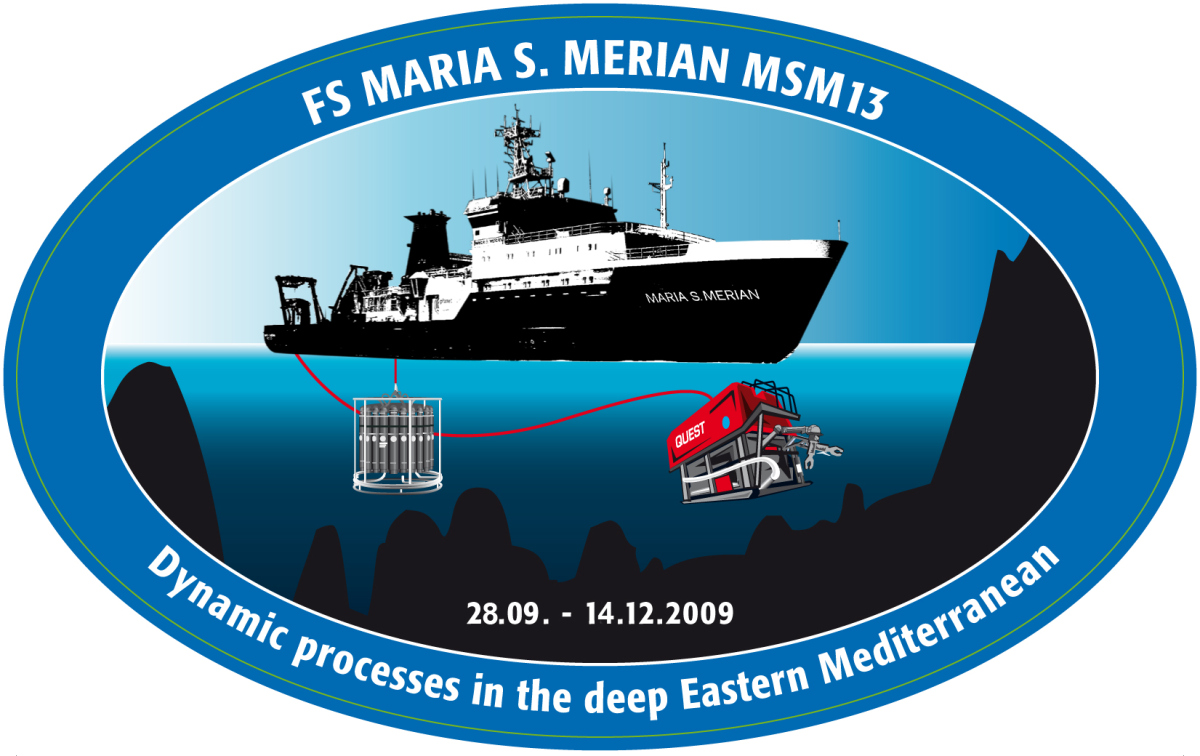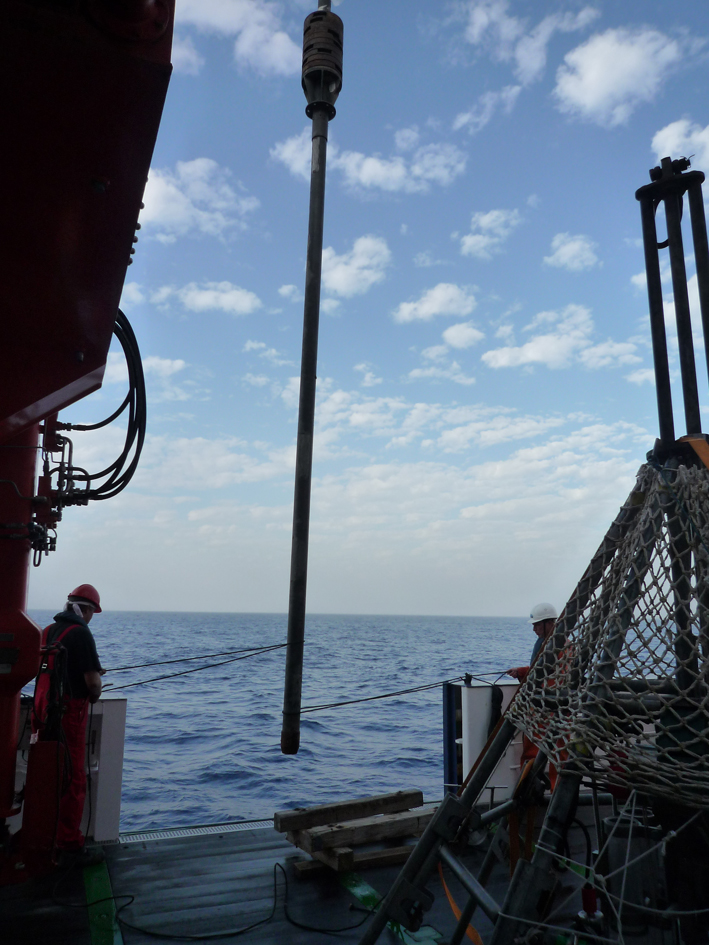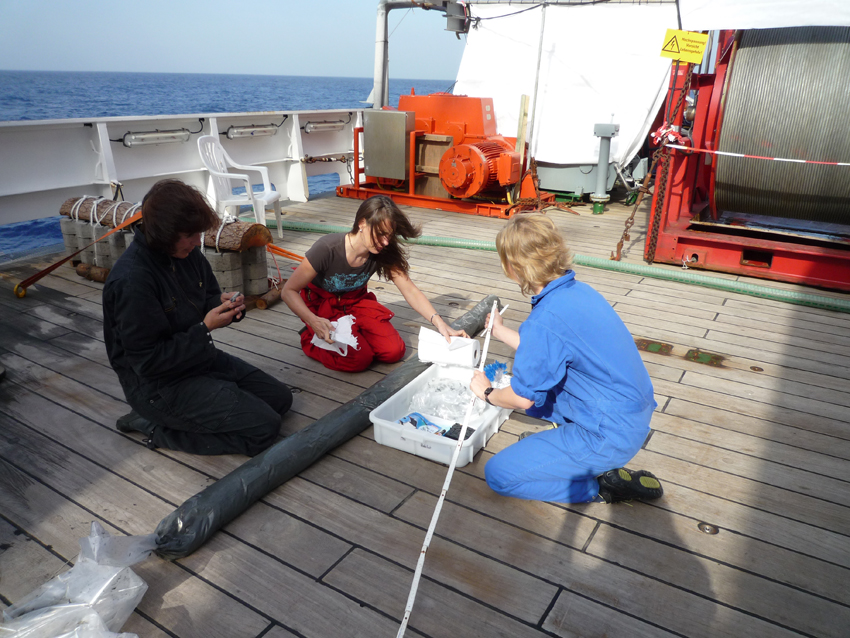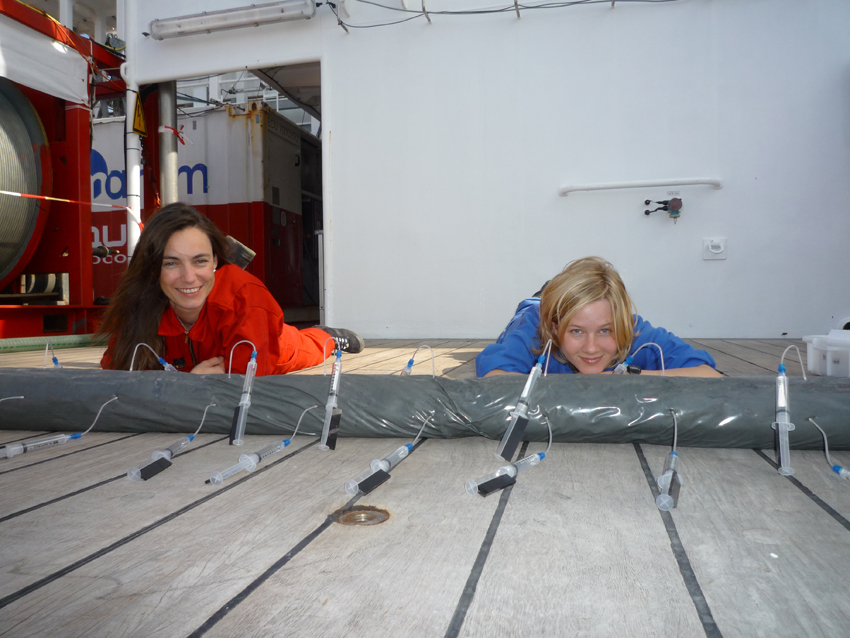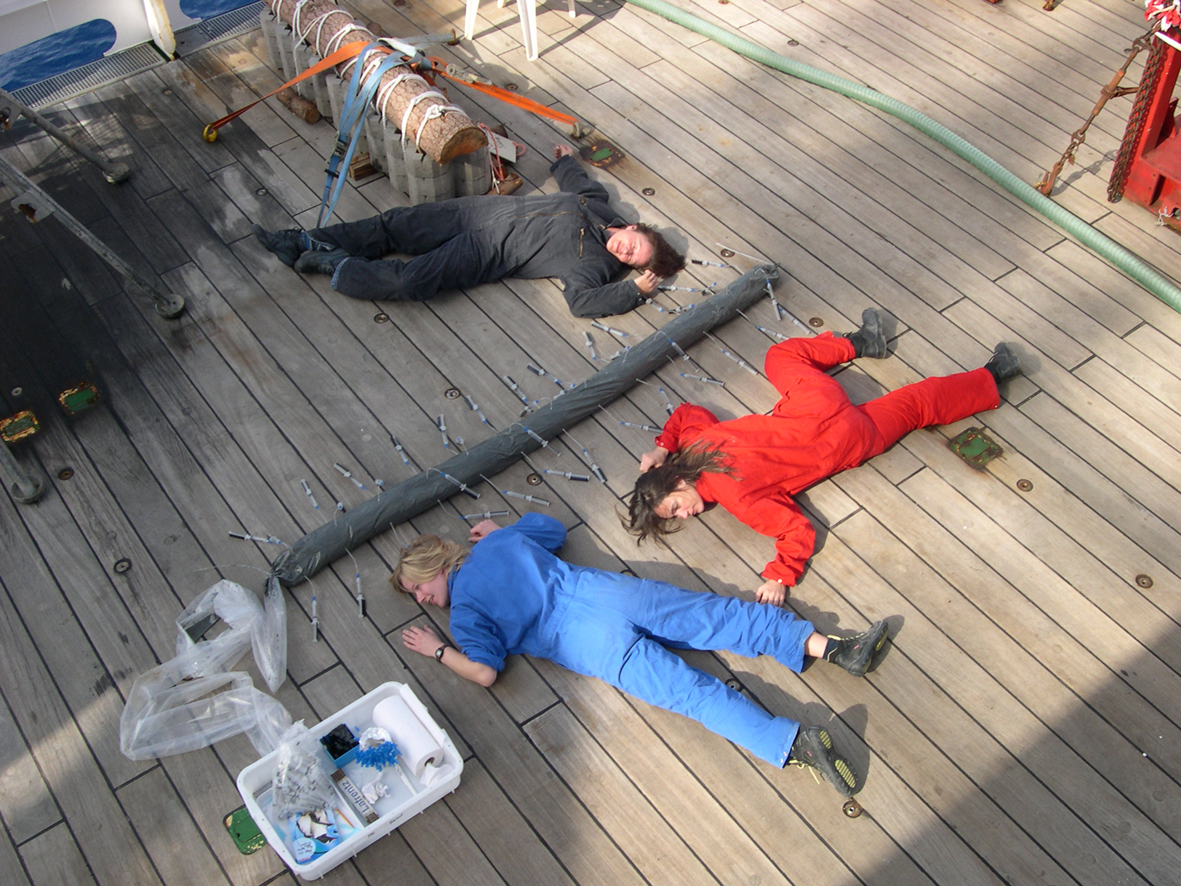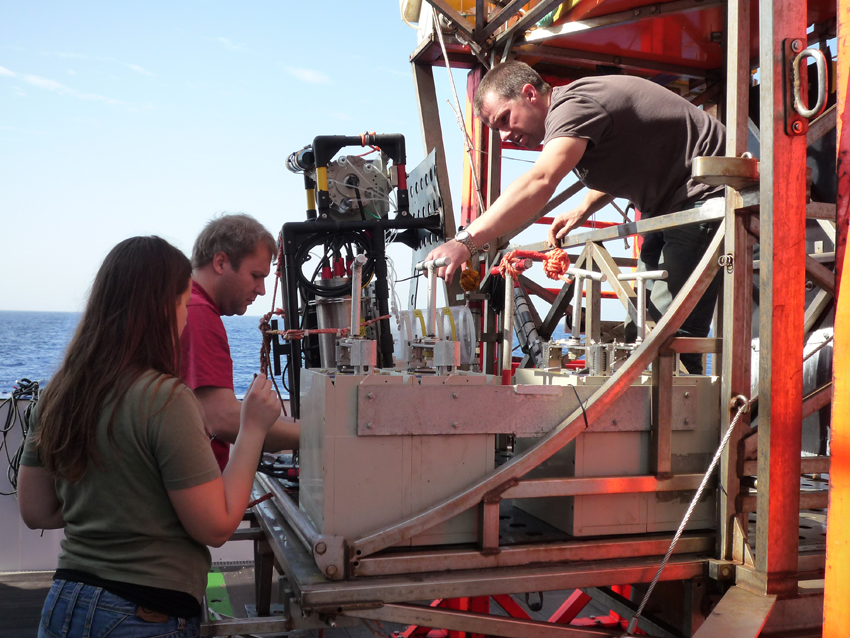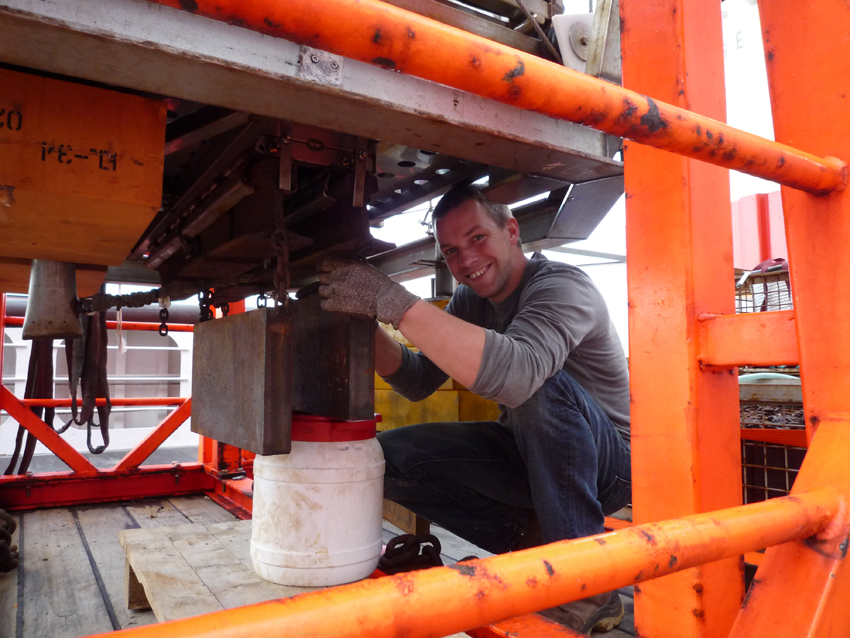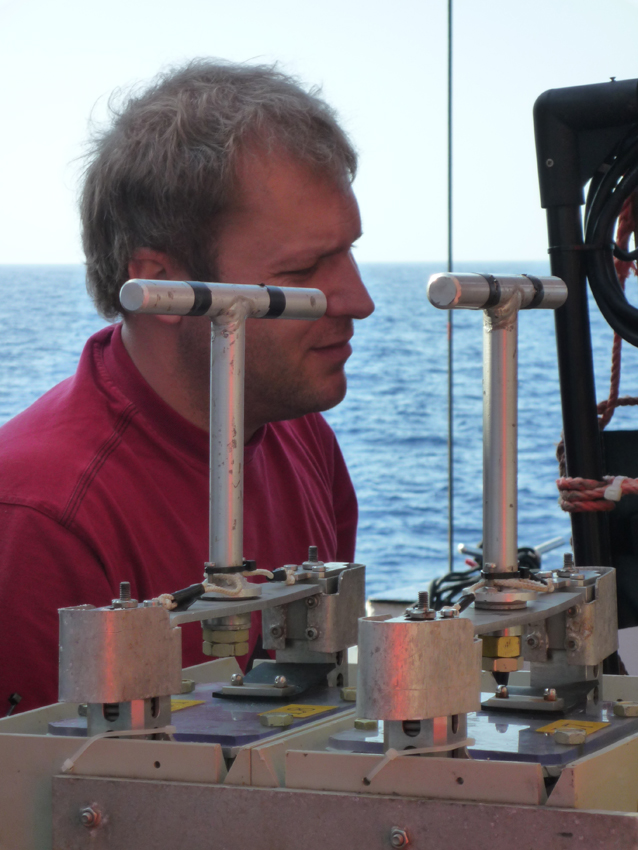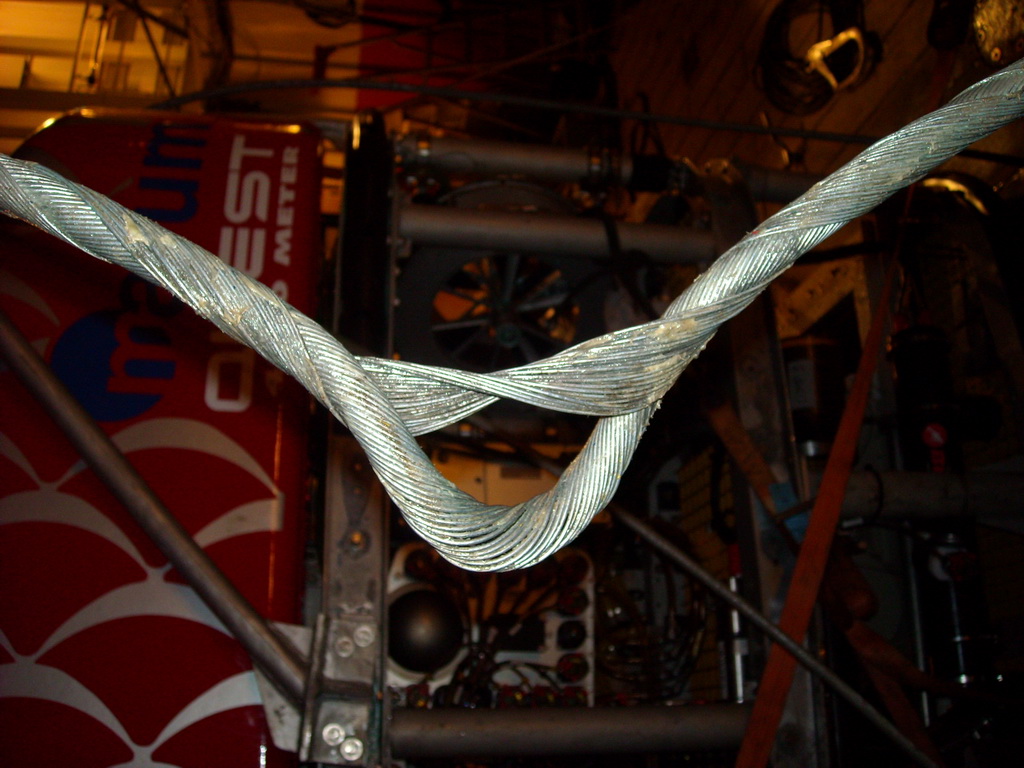Seitenpfad:
Weblog6
Weblog 6
08.11.-11.11.
Problems and solutions
On Sunday 8 November we started with two gravity cores to analyze the geochemical composition of the subsurface fluids in the center of the mud volcano. We have to solve an interesting enigma that we encountered during sampling in 2006. In the center of the mud volcano we noted almost perfect conditions for anaerobic hydrocarbon degrading microbes: abundant chemical energy from depth rising together with the seawater salt constituent sulfate. Sulfate can be used by microbes for respiration, to gain energy for biomass production. But we were really surprised in 2006 to learn that the microbes were not using the abundant energy source, and hence the hydrocarbons passed to the overlying seawater – although there was enough sulfate rising through the sediments from a deep source. So we planned a big experiment, to find out whether there was something in the fluids that would repress microbial activity. There is one easy way to tell whether microbes are using sulfate – it stinks. The waste product of sulfate respiration is hydrogen sulfide, of which a few molecules are enough to let every one make a face. (The sulfide stink is best known from rotting eggs.)
08.11.-11.11.
Problems and solutions
On Sunday 8 November we started with two gravity cores to analyze the geochemical composition of the subsurface fluids in the center of the mud volcano. We have to solve an interesting enigma that we encountered during sampling in 2006. In the center of the mud volcano we noted almost perfect conditions for anaerobic hydrocarbon degrading microbes: abundant chemical energy from depth rising together with the seawater salt constituent sulfate. Sulfate can be used by microbes for respiration, to gain energy for biomass production. But we were really surprised in 2006 to learn that the microbes were not using the abundant energy source, and hence the hydrocarbons passed to the overlying seawater – although there was enough sulfate rising through the sediments from a deep source. So we planned a big experiment, to find out whether there was something in the fluids that would repress microbial activity. There is one easy way to tell whether microbes are using sulfate – it stinks. The waste product of sulfate respiration is hydrogen sulfide, of which a few molecules are enough to let every one make a face. (The sulfide stink is best known from rotting eggs.)
So what we found out is something else: now, in 2009, the microbes are as active as hell. Obviously what we had sampled in 2006 was a major new mud flow, where microbial communities degrading hydrocarbons anaerobically had simply not yet developed. Three years later, they certainly are, and every sample from the mud flow stinks of sulfide. Enigma solved.
Also on Sunday the 8 November, we were treated to a royal surprise lunch by our fabulous cook and his team. It really felt like a Sunday – at least during lunch time. During the scientific meeting - which takes place every day at 3:30 pm to report on the most recent results and to plan the next dives - we collected all the remaining scientific wishes till the end of the cruise, and found out that we still have quite some work ahead of us, needing a dive every day.
The afternoon was spent on a short dive 246, to achieve a better mapping of flares and associated emissions from the seafloor, as well as carrying out a few more biogeochemical measurements. Everything worked really great till the ROV was recovered on deck shortly before midnight. What a blow: We were all very disappointed to see that the cable of the ROV was again twisted and now needs a major repair.
So the next day (9 November) went by with Parasound, Multibeam transects, videoguided multicorer sampling. Everyone used the occasion to work up samples. The ROV team was busy with steaming out the cable to get rid of turns, with cutting the cable and fixing a new plug, and finally another dive was planned for the morning of the 10th November.
Also on Sunday the 8 November, we were treated to a royal surprise lunch by our fabulous cook and his team. It really felt like a Sunday – at least during lunch time. During the scientific meeting - which takes place every day at 3:30 pm to report on the most recent results and to plan the next dives - we collected all the remaining scientific wishes till the end of the cruise, and found out that we still have quite some work ahead of us, needing a dive every day.
The afternoon was spent on a short dive 246, to achieve a better mapping of flares and associated emissions from the seafloor, as well as carrying out a few more biogeochemical measurements. Everything worked really great till the ROV was recovered on deck shortly before midnight. What a blow: We were all very disappointed to see that the cable of the ROV was again twisted and now needs a major repair.
So the next day (9 November) went by with Parasound, Multibeam transects, videoguided multicorer sampling. Everyone used the occasion to work up samples. The ROV team was busy with steaming out the cable to get rid of turns, with cutting the cable and fixing a new plug, and finally another dive was planned for the morning of the 10th November.
Again, the dive 247 was a great success. In less than 10 hours bottom time, we got 16 seafloor samples, 3 wood logs from our experiments, a set of 3 successful in situ measurements, and interesting observations on seafloor morphology and fluid escape pathways. But then another shock: after all the repairing, the cable was again so terribly twisted and turned that we had to cancel today’s dive, and to come up with a “Plan B”. The worst feeling is not to know the reason for these cable damages, and hence not being able to find immediate solutions. Second comes the worry not to be able to finish the tasks as hoped for, and as prepared for – despite the fact that the weather is perfect and the ROV too…except for its cable.
Twisted… Issues with the Cable lead to short nights and long days for the ROV team. Source: Volker Ratmeyer
So we have a couple of options for adapting the dive plans and the working hours to optimize results, even if we dive only every second day. The ROV team is looking carefully into each of the procedures of ROV deployment, diving and recovery, to look for possible sources of impact on the cable. Also we are talking to numerous experts including the captain and boatswain of MERIAN, to be sure not to miss an important detail. We really hope to find a solution before the end of the leg, because the next leg is equally dependent on dive time.
Meanwhile, the work continues with gravity cores, mapping and video-transects using the fiber cable of the ship. And just as I write (11 November, 6 pm) the ROV team leader has informed me that we can prepare for the next dive 248, which will allow us to finish one more task at the chemosynthetic habitats of the outer mud flows. We will dive during the night and come up tomorrow morning (12 November), hopefully this time with an intact cable. Wish us luck…
Antje Boetius
Meanwhile, the work continues with gravity cores, mapping and video-transects using the fiber cable of the ship. And just as I write (11 November, 6 pm) the ROV team leader has informed me that we can prepare for the next dive 248, which will allow us to finish one more task at the chemosynthetic habitats of the outer mud flows. We will dive during the night and come up tomorrow morning (12 November), hopefully this time with an intact cable. Wish us luck…
Antje Boetius

